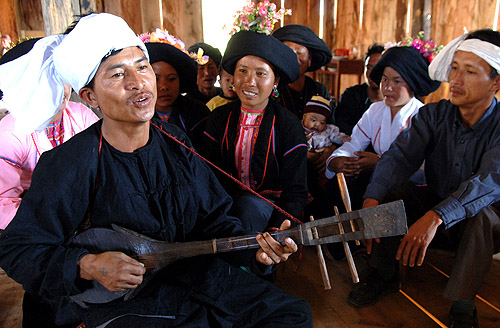|
 |
|
UNIQUE ART: A villager living in the Bulang Ethnic Ecomuseum performs a folk song for local residents (XINHUA) |
Settled in the mist-covered mountains of Liuzhi Special Zone in southwest China's Guizhou Province, the Soga people, a subgroup of the Miao ethnic group with a population of less than 5,000, are mysterious to the outside world. Today, Soga people still adhere to traditional primitive practices, with men planting and women weaving cloths. They preserve a unique Miao ethnic culture, including traditional ceremonies for big events, folk music, dance and art. But with no written language, the Soga people can only pass down the tales and memories of their people through stories and songs—and they continue to do this today. In 1997, Soga Miao Ethnic Ecomuseum was built to preserve the Miao traditional culture.
Besides the Soga Ecomuseum, Guizhou also has the Dong Ethnic Ecomuseum in Tang'an, the Bouyei Ethnic Ecomuseum in Zhenshan and the Han Ethnic Ecomuseum in Longli. There is also an ecomuseum for the Yao ethnic group in Nandan County of Guangxi Zhuang Autonomous Region and an ecomuseum for the Mongolian ethnic group in Olunsum of the Inner Mongolia Autonomous Region. These ecomuseums are the first batch of ecomuseums that China has set up, and most of them are situated in remote areas that maintain preindustrial lifestyles.
In the 1980s, as China began to industrialize, ecological imbalances and environmental pollution began to become a serious problem in the country. Environmental protection began drawing more attention from the government and people. Under pressure to protect the environment and China's cultural heritage, the notion of ecomuseums was introduced.
Fenceless museums
Ecomuseums differ from traditional museums in that they protect the original habitats of a certain cultural branch. The exhibits of these museums are the actual houses, rivers, festivals and traditions of a particular ethnic group. These special museums, like their traditional counterparts, still convey the message of change over time.
In different countries, ecomuseums are managed in different ways. China has learned from advanced foreign experience in establishing and managing its first batch of ecomuseums.
Ecomuseums have dual functions—promoting regional development and protecting cultural heritage. In east China, rapid economic development has given rise to a fragile ecological environment and destruction of heritage sites. People in the area now realize the necessity to coordinate development while preserving their past and protecting the environment. That's where ecomuseums come in.
Su Donghai, a researcher with the Chinese Society of Museums, who is widely recognized as the father of China's ecomuseums, started a campaign to promote ecomuseums in China as early as 1986. In 2005, he organized and presided over the International Ecomuseum Forum in Guizhou. About 100 researchers from 15 countries attended the forum, discussing and exchanging views upon sustainable development of ecomuseums around the world.
Shan Jixiang, Director of the State Administration of Cultural Heritage, proposed in 2006 to set up ecomuseums in developed areas around China, since cultural heritage disappears more quickly in wealthy regions where the economy develops faster.
"With the modernization of rural areas, traditional agriculture is being replaced by modern agriculture, traditional farmhouses by modern architecture, and indigenous culture by other cultures," said Su. "Because of these radical changes in the rural areas, the valuable and the backward part of agricultural civilization are disappearing at the same time. It's urgent that we protect and embrace the spiritual legacy of traditional culture."
| 